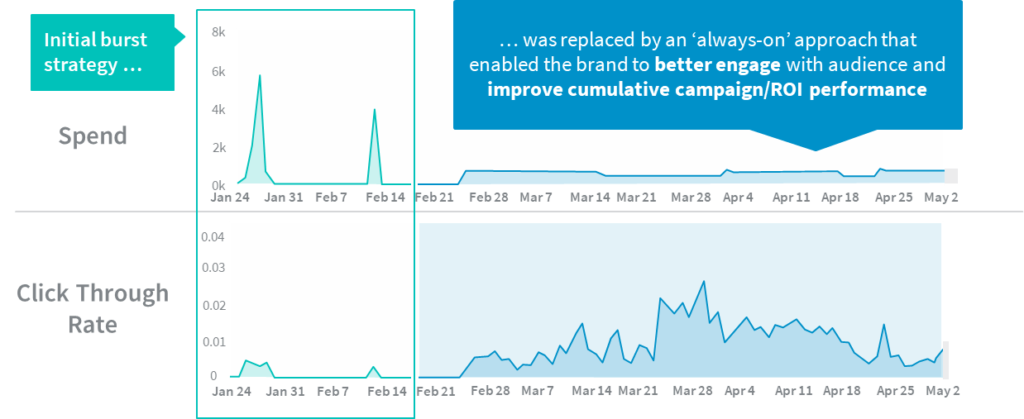

As a Social Media Manager, I’ve run a large number of social campaigns in my career. The majority of these match the following description: short-term, usually event/time-based, align with quarterly budgets, and include a fixed end date. After which, there can be long periods of time the brand goes dark until the next campaign launches. Sound familiar? What if I told you there was a better way—one that was more in-line with your customers’ behaviors and could provide not only cost savings but also boost performance? Look no further than an always-on paid social media strategy. Let’s discuss what it is and how it can benefit your business and marketing efforts.
What is always-on paid social?
Simply put, always-on paid social is the act of evenly distributing budgets and paid social campaigns across the entire year, always having active ads in at least one channel. It’s also important to note up front that always-on isn’t asking for a bigger budget, rather a redistribution of the existing budget, pacing it more evenly throughout the year. In essence, always-on paid social marketing is a form of content marketing, and content marketing should be always-on marketing. Think about your brand’s website—it’s always on due to perpetual interest, potentially at any hour or day of the week. Why wouldn’t you apply the same logic to your other marketing efforts, especially those in the fast-paced, ever-changing world of social media?
There are two critical reasons why you should employ an always-on paid social strategy:
1. B2B Decision Makers and the Buyer’s Journey Are Always On
Here are some flooring statistics if this doesn’t seem painfully obvious enough: according to LinkedIn internal data, 69% of B2B decision-makers research business products during their workday, 73% research in the evenings, and 51% spend time researching on the weekends. That means that the odds are high that someone is always researching for a product/service in your space. While we’d like to think of the buyer’s journey as linear and simple, it’s actually a tangled mess, with decision-makers flipping between company websites, social, email, peer recommendations, review sites and so much more. On top of that, many of them are likely at different stages of the sales cycle.
It’s also important to consider the length of the B2B buyer cycle and what’s required to pull a prospect completely through the funnel. According to Facebook internal data and research, B2B buying cycles can be anywhere from 30 to 180 days, depending on the business—and enterprise decisions take even longer on average. Getting prospects to take that journey typically involves up to 10 pieces of content being consumed to reach a decision, and a B2B SaaS company, for instance, needs between six and 16 touch-points with a prospect to create a viable sales lead. Time-sensitive, short-term campaigns are unable to meet all of this demand.
2. Paid Social Becomes More Efficient from both a Performance and Cost Perspective
Everyone’s looking to optimize performance and reduce costs of their marketing campaigns, and always-on is a great way to do so with your paid social. Most paid social campaigns are based on a bidding system to get your ads shown. Just like with the stock market, when the price is variable, consistent spend is a smarter strategy. A pulsing, or “on and off” media budget leads to inconsistent click-through rate (CTR) performance. LinkedIn conducted a study of one of its advertisers, comparing types of spend over several months and shared the (anonymized) information with us. The difference is clear:

Wouldn’t you rather show your CMO the CTRs in blue? Me too. This same study also found that during a period of always-on, consistent spend, the client was able to achieve three times its usual daily reach. Brand awareness also saw an uplift in this same study, with the client achieving a 12% increase during a period of continuous spend, and a 9% decrease when paid social media stopped.
Here are a few platform-specific benefits of an always-on paid social strategy:
LinkedIn: Maintain a high relevancy score. All ads run on LinkedIn have a relevancy score. This is a score that measures how engaging campaigns are to a specific target audience. It’s a combination of relevancy score and the bid amount that determines whether your ad will run. The stronger your relevancy score is, the lower the bid required to win impressions and clicks. If your brand’s paid social goes dark for more than two weeks in a row, your relevance score is deleted and you have to start all over. This means inefficiency: higher CPCs and bids, as well as a longer campaign ramp-up.
Facebook: Create effective prospecting. This is a great way to ensure your business has a constant flow of 1st party audiences for its campaigns in social and elsewhere, especially if it’s based on the Facebook pixel being implemented on your pages. Feed the top of the funnel and create scalable retargeting audiences.
Twitter: Increase ROAS, sales lift, and frequency. Twitter has conducted its own internal research on the topic and shared with us some encouraging statistics. When comparing always-on campaigns to shorter, event-style campaigns, Twitter found there was an 18% increase in both the median return on spend (ROAS) and median sales lift. Always-on also created a 40% increase in median frequency, which is great for staying top of mind during long sales cycles.
Now that you know why always-on paid social is important and what some of its benefits are, it’s time to consider strategy. Consistent education is critical to an always-on paid social strategy, and we’ll leave you with that thought. Strategy is an important topic and deserves its own blog since I could fill another 1,000 words with strategy alone. Look for a future blog post where we do a deep dive into strategy ideas on how to execute an always-on paid social campaign.

